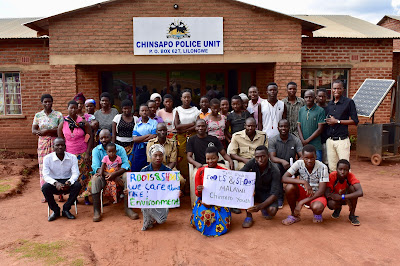THE "CHINSAPO" SPAY CLINIC IN FEBRUARY THE SPAY MONTH
Chinsapo is just about a 7-10 minute drive from the central
business district of old town in Lilongwe, although it is very close to the
city’s hub, Chinsapo is an urban,
high density, low income area. And as is the case with many Malawian families,
many families in Chinsapo have pets.
The most common being cats and dogs, but it has been the case, again as is the
case with in many low income communities in Malawi that the cats and dogs are
barely ever spayed or neutered. This is not due to the fact that the people in
these communities know nothing about spaying and neutering but has more to do
with the depth of knowledge on the benefits of spay and neuter. Another reason
why the dogs and cats in these communities are barely spayed or neutered is
because the people in these communities are unable to pay for the required
surgery as they cannot afford to due to the strength of their earning power.
All of these factors led to the selection of Chinsapo as the project area of a
week-long spaying and neutering exercise. This exercise was the second phase of
the free “Spay and Neuter” services that All
Creatures was offering in the month of February. The first phase was held
at the All Creatures Animal Resource Centre
where we conducted 32 operations in total on the dogs that are currently in our
care awaiting adoption and also of the inhabitants of Lilongwe who were able to
bring their dog for the surgery and one cat.
Once the first phase was complete, we went one to Chinsapo a community with which we
already previously established a rapport, and so as is the custom we sought
permission from the chief of the area and he granted the go ahead. When we work
in these communities, it is always wonderful to witness the huge level of
partnership between us and the people in the community. We never work in
isolation as the people are always willing to assist, and in this case after we
sought permission the chief and his people took up the responsibility of
publicizing the exercise.
The team headed by Dr Delphine Rwemalika, supported
by a Zambian Vet Dr Mwaba Sichande, Dr Marvin Phonera, Dr. Picken Chigoma and also
Tiwonge Kwanunkhatonde, Kumbukani Mazonde, Ellen Lambulira and Joshua Nyasulu started the work on Monday 20th February;
the reception on the first day was quite lukewarm as not many people showed up
to access the service. However, things picked up the next day and the days that
followed, keeping the team extremely busy. Business usually started at around
9 am and run all the way through to 5 or 6 pm when the final surgery would be
concluded with barely any time in between for a lunch break which was often had
late. On very few occasions the team would conclude at 4 pm, these were the days
where there were few clients.
The team faced one major setback during the course of the project, as the exercise started out, the team was allowed to use of an unfinished hospital building that is still under construction within the community. After four days of using the hospital building, the team was disallowed from using the building any further without any explanations given. Excuse upon excuse was given to dissuade the team from using the building. The team quickly re-strategized and sourced some tents which were brought in and mounted; the rest of the exercise was conducted from there. But this solution presented another problem, though slight, but a challenge all the same. Due to the fact that the tents have no walls, it was quite a task trying to keep at bay the kids whose curiosity could not be denied. But ultimately, the dedication of the team saw to the sterilization of 143 dogs and cats by the end of the project, 33 of which were sterilized in the first phase, and 110 of them in the second phase in Chinsapo. And even though we set out to sterilize cats and dogs, we only sterilized 2 cats, one in each phase.
The team faced one major setback during the course of the project, as the exercise started out, the team was allowed to use of an unfinished hospital building that is still under construction within the community. After four days of using the hospital building, the team was disallowed from using the building any further without any explanations given. Excuse upon excuse was given to dissuade the team from using the building. The team quickly re-strategized and sourced some tents which were brought in and mounted; the rest of the exercise was conducted from there. But this solution presented another problem, though slight, but a challenge all the same. Due to the fact that the tents have no walls, it was quite a task trying to keep at bay the kids whose curiosity could not be denied. But ultimately, the dedication of the team saw to the sterilization of 143 dogs and cats by the end of the project, 33 of which were sterilized in the first phase, and 110 of them in the second phase in Chinsapo. And even though we set out to sterilize cats and dogs, we only sterilized 2 cats, one in each phase.












Comments
Post a Comment